Nvidia announced RTX 5090, RTX 5080, RTX 5070 Ti and RTX 5070 GPUs. Also announced DLSS 4 Multi Frame Generation. The RTX 5090 will cost $1,999.
After months of rumors and speculations, Nvidia’s Jensen Huang officially announced (YouTube) the RTX 50 series, including its flagship GeForce RTX 5090, the RTX 5080, RTX 5070 Ti and RTX 5070. There’s no mention of RTX 5060 series, it’s expected to come some months later.
The flagship RTX 5090 graphics card comes with 92 billion transistors. The series comes with optimized streaming multiprocessor with more throughput, better Tensor Cores integration with improved neural shaders performance. It also comes with new RT Cores with 2X the ray triangle intersection rate and enhanced compression to reduce VRAM usage.
Nvidia GeForce RTX 50 series also comes with GDDR7 graphics card memory (VRAM), first in consumer graphics cards.
Nvidia also announced DLSS 4 with Multi Frame Generation. But more on that later.
RTX 5090 & Others Specs
First the specs.
| Graphics Card | RTX 5090 | RTX 5080 | RTX 5070 Ti | RTX 5070 |
|---|---|---|---|---|
| CUDA Cores | 21760 | 10752 | 8960 | 6144 |
| Tensor Cores (AI) | 5th-Gen 3352 AI TOPS | 5th-Gen 1801 AI TOPS | 5th-Gen 1406 AI TOPS | 5th-Gen 988 AI TOPS |
| Ray Tracing Cores | 4th-Gen 318 TFLOPS | 4th-Gen 171 TFLOPS | 4th-Gen 133 TFLOPS | 4th-Gen 94 TFLOPS |
| Base Clock | 2.01GHz | 2.30GHz | 2.30GHz | 2.16GHz |
| Boost Clock | 2.41GHz | 2.62GHz | 2.45GHz | 2.51GHz |
| VRAM | 32 GB GDDR7 | 16 GB GDDR7 | 16 GB GDDR7 | 12 GB GDDR7 |
| Bandwidth | 1792 GB/s | 960 GB/s | 896 GB/s | 672 GB/s |
| Bus Width | 512-bit | 256-bit | 256-bit | 192-bit |
| DLSS Version | DLSS 4 | DLSS 4 | DLSS 4 | DLSS 4 |
| Slot (FE) | 2-Slot | 2-Slot | Varies | 2-Slot |
| Max Temps | 90C | 88C | 88C | 85C |
| TGP | 575W | 360W | 300W | 250W |
| PSU Requirement | 1000W | 850W | 750W | 650W |
| Power Connector | 1x 600W PCIe 5.0 | 1x 450W PCIe 5.0 | 300W PCIe 5.0 | 300W PCIe 5.0 |
| MSRP | $1,999 | $999 | $749 | $549 |
Some specs comparison.
RTX 5090 vs RTX 4090
| Graphics Card | RTX 5090 | RTX 4090 |
|---|---|---|
| GPU | GB202* | AD102 |
| CUDA Cores | 21760 | 16384 |
| Tensor Cores (AI) | 5th-Gen 3352 AI TOPS | 4th-Gen 1321 AI TOPS |
| Ray Tracing Cores | 4th-Gen 318 TFLOPS | 3rd-Gen 191 TFLOPS |
| Base Clock | 2.01GHz | 2.23GHz |
| Boost Clock | 2.41GHz | 2.52GHz |
| VRAM | 32 GB GDDR7 | 24 GB GDDR6X |
| Bandwidth | 1792 GB/s | 1008 GB/s |
| Bus Width | 512-bit | 384-bit |
| DLSS Version | DLSS 4 | DLSS 3 |
| Slot (FE) | 2-Slot | 3-Slot |
| Max Temps | 90C | 90C |
| TGP | 575W | 450W |
| PSU Requirement | 1000W | 850W |
| Power Connector | 1x 600W PCIe 5.0 | 1x 450W PCIe 5.0 |
| MSRP | $1,999 | $1,599 |
RTX 5080 vs RTX 4080 Super
| Graphics Card | RTX 5080 | RTX 4080 Super |
|---|---|---|
| GPU | GB203* | AD103 |
| CUDA Cores | 10752 | 10240 |
| Tensor Cores (AI) | 5th-Gen 1801 AI TOPS | 4th-Gen 836 AI TOPS |
| Ray Tracing Cores | 4th-Gen 171 TFLOPS | 3rd Gen 121 TFLOPS |
| Base Clock | 2.30GHz | 2.29GHz |
| Boost Clock | 2.62GHz | 2.55GHz |
| VRAM | 16 GB GDDR7 | 16 GB GDDR6X |
| Memory Bandwidth | 960 GB/s | 736 GB/s |
| Bus Width | 256-bit | 256-bit |
| DLSS Version | DLSS 4 | DLSS 3 |
| Slot (FE) | 2-Slot | 3-Slot |
| Max Temps | 88C | 90C |
| TGP | 360W | 320W |
| PSU Requirement | 850W | 750W |
| Power Connector | 1x 450W PCIe 5.0 | 1x 450W PCIe 5.0 |
| MSRP | $999 | $999 |
RTX 5070 Ti vs RTX 4070 Ti Super
| Graphics Card | RTX 5070 Ti | RTX 4070 Ti Super |
|---|---|---|
| GPU | GB203* | AD103 |
| CUDA Cores | 8960 | 8448 |
| Tensor Cores (AI) | 5th-Gen 1406 AI TOPS | 4th-Gen 706 AI TOPS |
| Ray Tracing Cores | 4th-Gen 133 TFLOPS | 3rd-Gen 102 TFLOPS |
| Base Clock | 2.30GHz | 2.34GHz |
| Boost Clock | 2.45GHz | 2.61GHz |
| VRAM | 16 GB GDDR7 | 16 GB GDDR6X |
| Memory Bandwidth | 896 GB/s | 672 GB/s |
| Bus Width | 256-bit | 256-bit |
| DLSS Version | DLSS 4 | DLSS 3 |
| Max Temps | 88C | 90C |
| TGP | 300W | 285W |
| PSU Requirement | 750W | 700W |
| Power Connector | 300W PCIe 5.0 | 300W PCIe 5.0 |
| MSRP | $749 | $799 |
RTX 5070 vs RTX 4070 Super
| Graphics Card | RTX 5070 | RTX 4070 Super |
|---|---|---|
| GPU | GB205* | AD104 |
| CUDA Cores | 6144 | 7168 |
| Tensor Cores (AI) | 5th-Gen 988 AI TOPS | 4th-Gen 568 AI TOPS |
| Ray Tracing Cores | 4th-Gen 94 TFLOPS | 3rd-Gen 82 TFLOPS |
| Base Clock | 2.16GHz | 1.98GHz |
| Boost Clock | 2.51GHz | 2.48GHz |
| VRAM | 12 GB GDDR7 | 12 GB GDDR6X |
| Memory Bandwidth | 672 GB/s | 504 GB/s |
| Bus Width | 192-bit | 192-bit |
| DLSS Version | DLSS 4 | DLSS 3 |
| Slot (FE) | 2-Slot | 2-Slot |
| Max Temps | 85C | 90C |
| TGP | 250W | 220W |
| PSU Requirement | 650W | 650W |
| Power Connector | 300W PCIe 5.0 | 300W PCIe 5.0 / 1x 8-pin |
| MSRP | $549 | $599 |
*Unconfirmed.
Performance
When it comes to performance, Nvidia claims that all these graphics cards, that is RTX 5090, RTX 5080, RTX 5070 Ti and RTX 5070 are 2X or twice the speed of their previous-gen versions. How? All thanks to DLSS 4.
Click on the slides to look at them.
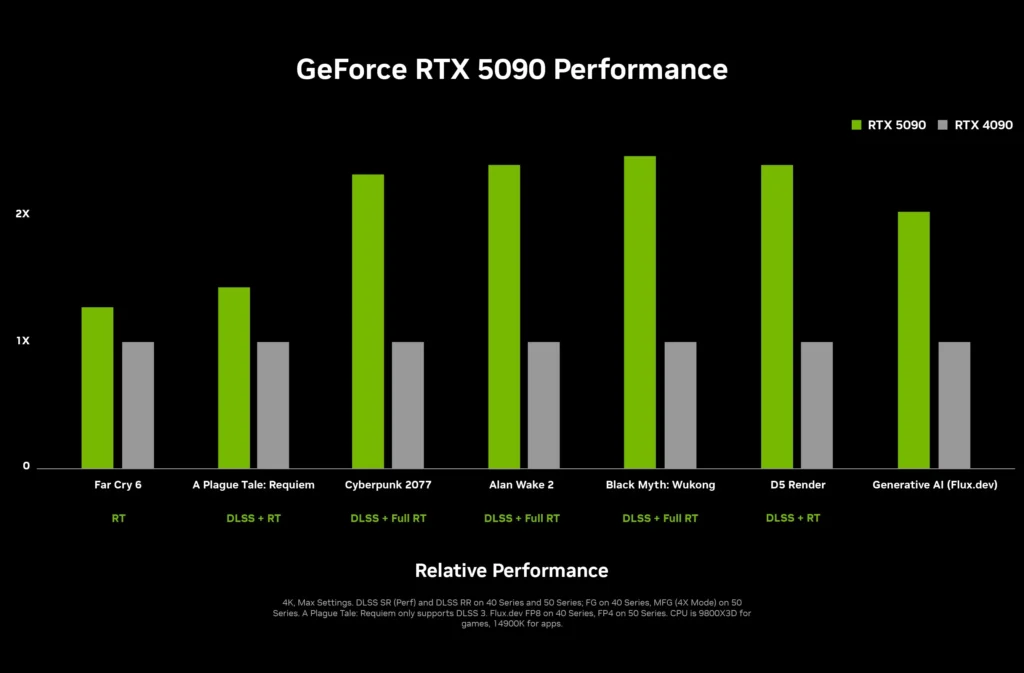
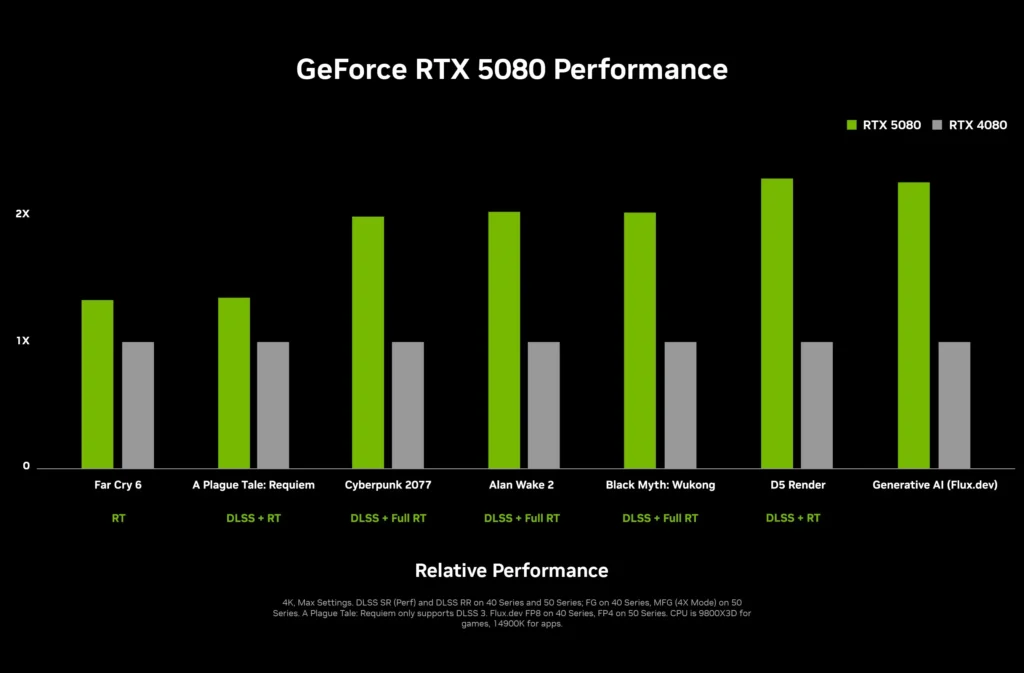
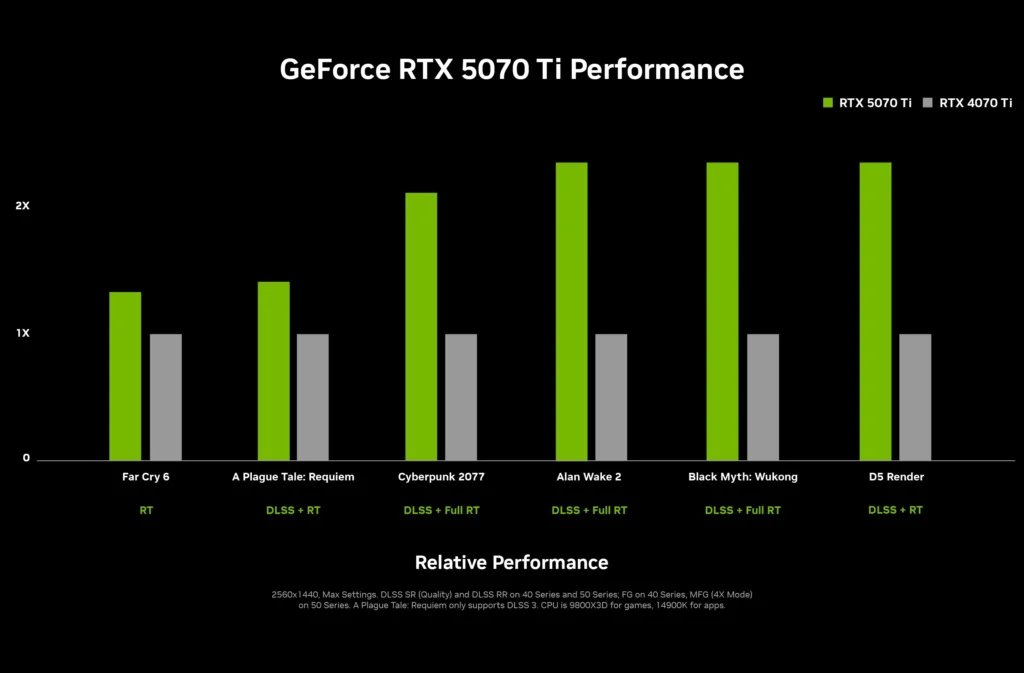
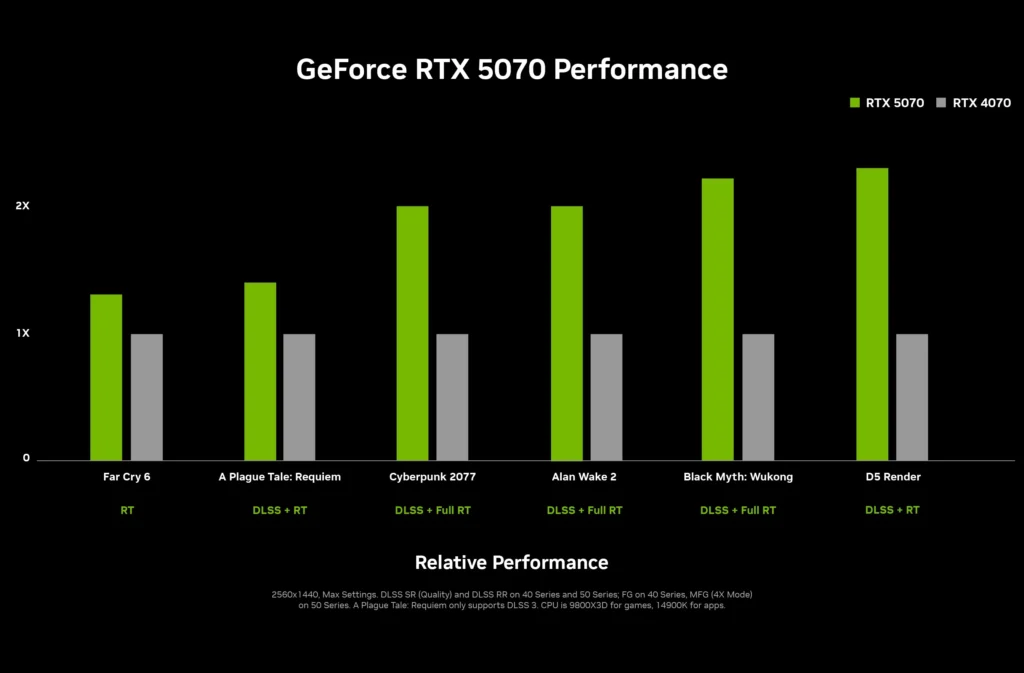
It must be mentioned that these are just marketing slides. One shouldn’t take them at face value until the reviews are publicly out.
During the keynote, Jensen Huang made an interesting claim.

He claimed that RTX 5070 will perform as fast as RTX 4090 at significantly reduced price. However, what he didn’t say specifically, is that he most likely meant it with DLSS 4 enabled on RTX 5070 compared to RTX 4090 without any DLSS. So point remains. Wait for reviews.
But what about DLSS 4. Let’s read about it.
DLSS 4 With Multi Frame Generation
Nvidia also announced RTX 50 series / RTX 5000 exclusive DLSS 4 with Multi Frame Generation. While DLSS 3 inserted a single frame between two frames, DLSS 4 Multi Frame Generation generates up to three additional frames per one traditionally rendered frame. This allows the frame rate to increase massively, up to 8X the rendered frame rate.
75 Games & Apps will immediately support the new DLSS 4 with Multi Frame Generation at the launch day itself.
Massive DLSS Upgrades For All RTX Graphics Cards
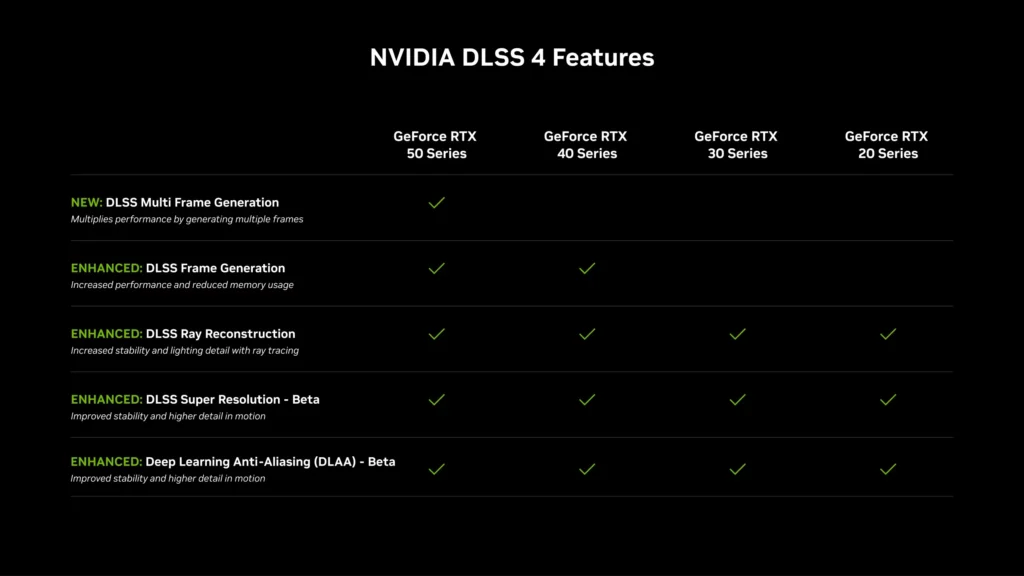
Not only that, Nvidia has also upgraded it’s DLSS Frame Generation, DLSS Ray Reconstruction, DLSS Super Resolution, and DLAA. With all cards that support them, including all previous-gen RTX cards to benefit from it.
For example, Nvidia claims that the new DLSS Frame Generation AI model is 40% faster & uses 30% less VRAM.
Nvidia has switched from Convolutional Neural Networks (CNNs) to DLSS transformer model, it generates pixels that offer greater stability, reduced ghosting, higher detail in motion, and smoother edges in a scene. In other words, higher quality DLSS, faster and less VRAM consuming. Including in Ray Tracing.
Additionally, Nvidia has announced Reflex 2 for all RTX graphics cards. It will further lower the latency by up to 75%.
Price And Release Date
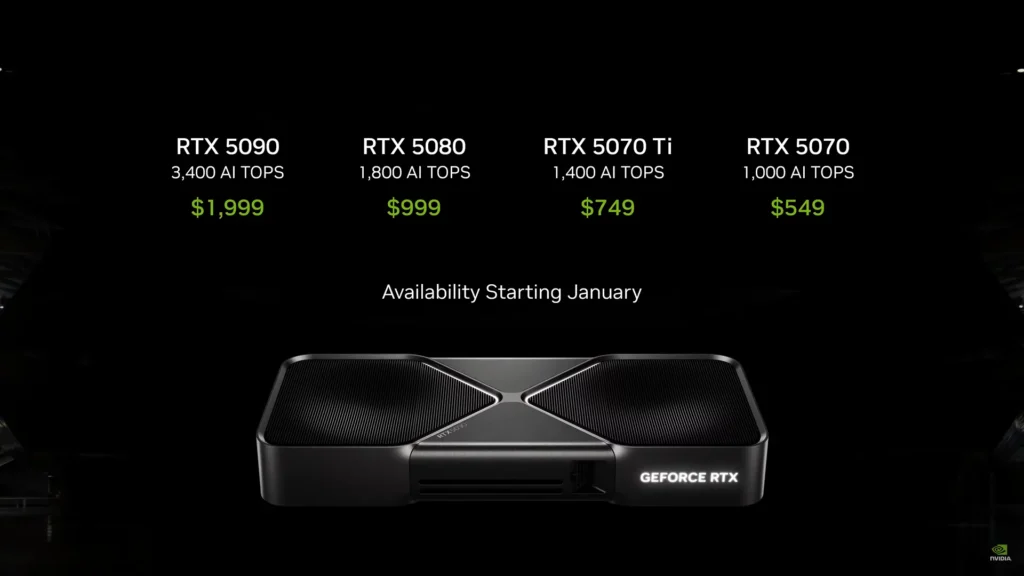
Nvidia GeForce RTX 5090 will cost $1,999 and release on 30th January. Nvidia GeForce RTX 5080 will release along with it and cost $999.
The Nvidia GeForce RTX 5070 Ti will cost $749, while Nvidia GeForce RTX 5070 will cost $549. Both of them will be available starting February.
The reviews from all the reviewers should be available on their release dates or around them.
Hope you enjoyed this news post.
Thank you for appreciating my time and effort posting news every day for many years.
News posts... 2023: 5,800+ | 2024: 5,700+
RIP Matrix | Farewell my friend ![]()


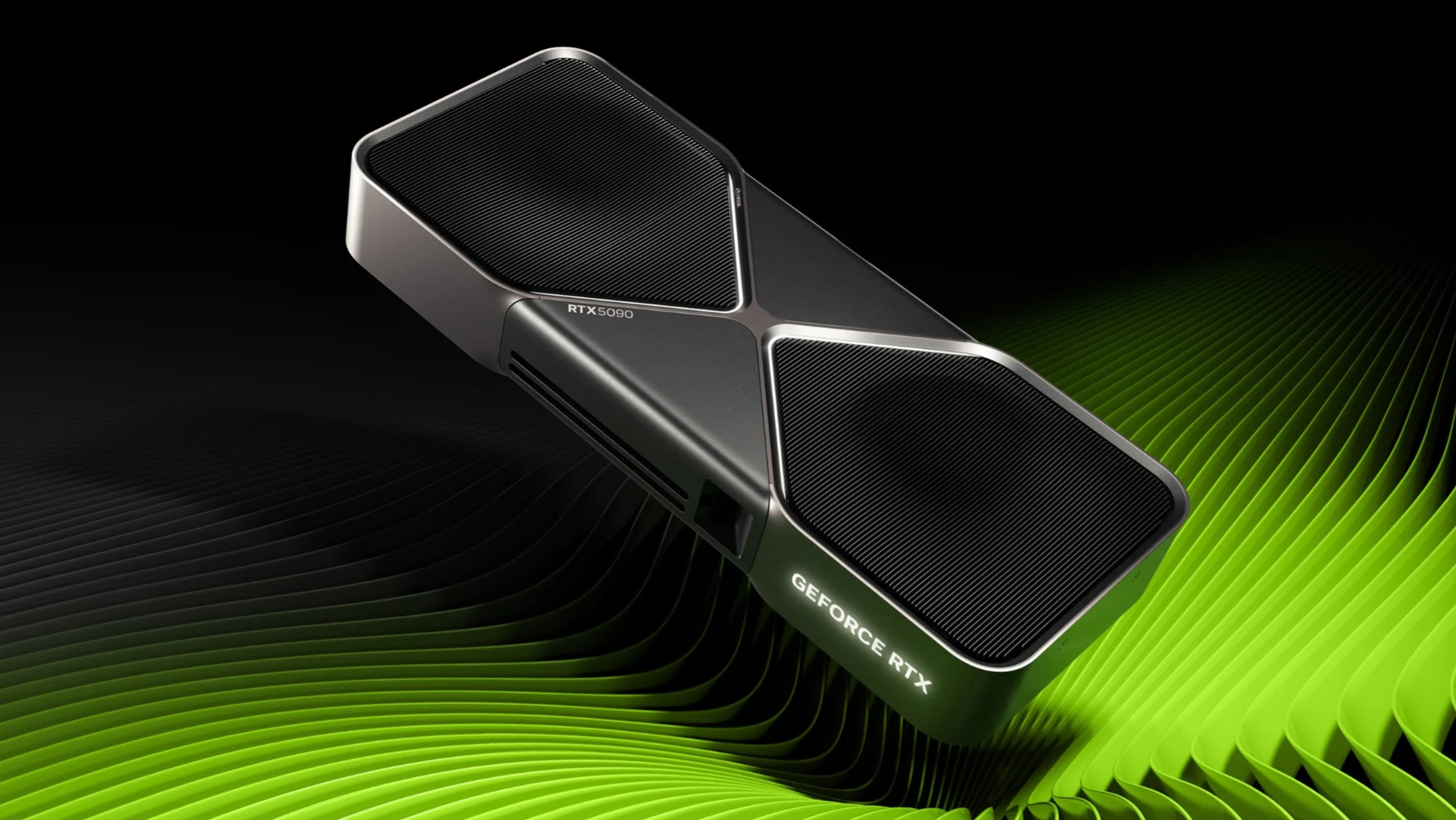
3175x175(CURRENT).thumb.jpg.b05acc060982b36f5891ba728e6d953c.jpg)


Recommended Comments
There are no comments to display.
Join the conversation
You can post now and register later. If you have an account, sign in now to post with your account.
Note: Your post will require moderator approval before it will be visible.